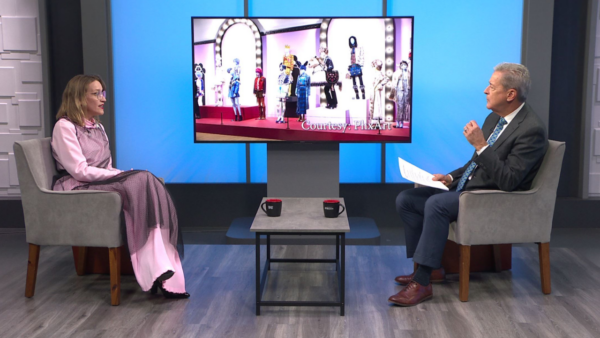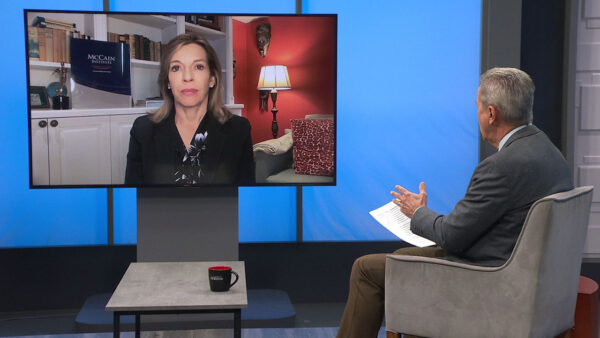How exactly did Congress achieve a deal on the debt ceiling and ending the shutdown, and what is the debt ceiling and why is it so important? Arizona State University Dean of Social Sciences Patrick Kenney will answer those questions.
Ted Simons: How exactly did Congress finally agree to raise the debt ceiling and get the federal government back up and operational? For some insight on that, we welcome Patrick Kenney, the dean of social sciences at ASU. Political science, go-to guy there. Good to see you again.
Patrick Kenney: Nice to see you.
Ted Simons: What was the actual deal here? What was agreed to?
Patrick Kenney: What was agreed to, first of all, open the government and allow the government to continue to borrow money. Those two things. Push those into next year. And then secondly, I think there was a very minor time delay in one minor aspect of the Obamacare, and that is a little bit tighter verification when people start to come on.
Ted Simons: And how did the deal finally get done? Give us the kind of machinations here. What happened?
Patrick Kenney: I think the reason that we finally got a deal, first of all, was that both sides -- there were majorities in both houses, both the House and Senate who could have voted to open the government all along. The Speaker of the House did not want to bring any kind of vote before the House that didn't have a majority of Republican support.
Ted Simons: Why is that? This is the Hastert rule.
Patrick Kenney: Right, which is named after Speaker Hastert. It comes during this time of real difficult negotiations between the parties. He was Speaker about a decade ago or so. And because the speakers owe to their own party, at least to bring legislation that has the balance and support of the majority of support in their party. It is in their interest and the interest of the cohesion of the party is why they try to do that.
Ted Simons: Basically the speaker could have voted on this all along, but because he didn't have a majority in his own party he never allow it to happen.
Patrick Kenney: Correct.
Ted Simons: What happened in the Senate? What was going on over there?
Patrick Kenney: Both parties had enough individuals that didn't want to see this happen. Both short- and long-term consequences to this, to the economy, standing in the world, with voters, with citizens. They didn't want to see that happen. On the Senate side, the reason it probably got brokered a little easier than on the House side, a few more moderate Republicans in the Senate, in particular women, who started to negotiate with some of the Democratic senators and that deal started to take shape.
Ted Simons: So we basically had -- it sounded like Mitch McConnell made the call to Harry Reid and said let's get the ball rolling.
Patrick Kenney: Right, exactly. A lot of pressure was mounting on both parties in particular. Polling was showing drops for both parties in approval, Republicans sharper than Democrats. But I suspect there was a lot of pressure from typical constituents that support the Republican Party (business, small and large, corporate support) that wanted this deal to get done.
Ted Simons: Antifraud measure was included, maybe a small hike in the debt ceiling. Shorter continuing resolution here as far as the government, but, again, critics look at this and say that all could have been handled weeks ago.
Patrick Kenney: Yes, exactly. What you had was a tactic by the Republicans in the House, all right, to try to get some changes in Obamacare, in the Affordable Care Act. They're in the minority across the House, Senate, and the presidency. They control one of the institutions. So, think the idea was if we put enough pressure on the President to not shut down and not go past the debt ceiling that we can get some changes, right? That was the logic. Most people don't think that logic ever was going to play out. The president wasn't going to go along with this. Let alone the Democrats in the Senate.
Ted Simons: Logic based on what critics of the move called a hostage-taking situation. Basically saying do this or else.
Patrick Kenney: That was the argument that they made. I think -- I think both houses of Congress have this ability to do this to one another, right, because of the way the system is set up. More of like a lever -- I mean leverage. They wanted leverage. They know they weren't going to get these changes otherwise, so they thought if we put leverage on these two important things, shutting the government down and the debt, we might get some movement on it. But most people didn't believe we would see any movement.
Ted Simons: We talked --
Patrick Kenney: One thing in particular, that the president -- I can't imagine an executive, Democrat or Republican yielding to this kind of pressure. That is very hard for a president to negotiate under those kinds of circumstances. I didn't think at any -- let alone whether it was on Obamacare or not, to have the House of Representatives saying to the president, you either do this or, very difficult time for the president to negotiate.
Ted Simons: With that level of leverage, if you will, I've asked this before, this seems like a recent phenomenon. We saw this in the 90's, do this or else. The or else this time, and again not too long ago, includes the debt ceiling, which includes perhaps a default which includes instability and problems in the world and U.S. market. Have we seen things get that far, even as leverage, using something like that?
Patrick Kenney: That's unusual. We started it in the 80's really, with where you saw the -- where you saw the yearly deficits start to increase during the 80's and they had to move that debt up more than they wanted. And that's kind of continuing on. We always have these negotiations where the budget could be used to select different priorities. The spending around these programs. What is more dramatic now, I think, all right, is the parties are so far apart on these attitudes on about what they want to do. The two parties are so far apart that you get these kind of dramatic tactics and I think that's what is going on.
Ted Simons: Last question here. Obviously the tactics are designed to get something, to win something. By delaying this, by stretching this out and getting what you wound up getting, did the Republicans get momentum? Did they get a small W win, a small L lose? What was gained by all of these weeks of fussing and fighting?
Patrick Kenney: Right. I don't think they probably gained virtually nothing on this, the Republicans, and probably lost in standing. And I think one of the reasons for that is that the cost of this tactic, shutting the government down, whether we do financial cost, whether we do creditability around the world, on citizens, is pretty significant for what they could have gained right? The gain we always knew was going to be pretty small. The Senate Democrats weren't going to go along with it. Democratic president was not going to go along with this. There is a lot of cost for what was potentially there to gain probably.
Ted Simons: With that in mind real quickly, would you be surprised -- These things only go to January, February, would you be surprised to see the same tactics brought up again?
Patrick Kenney: I would not be surprised to see that. However, I think politically, it's way less likely in that short a term. I think there was enough damage done to the parties that there should be some negotiation between now and then, between the president and Democrats and Republicans to avoid that. But I would not be shocked, let's put it that way.
Ted Simons: All right. Good stuff. Thank you so much for joining us.
Patrick Kenney: You're welcome.
Patrick Kenney:Dean of Social Sciences, Arizona State University























